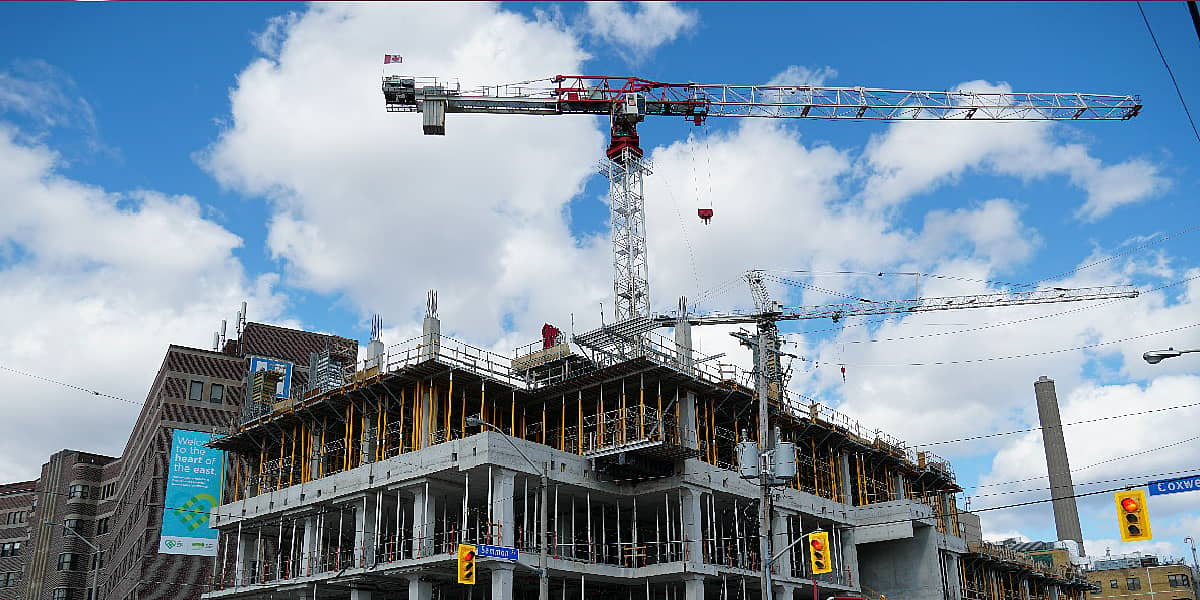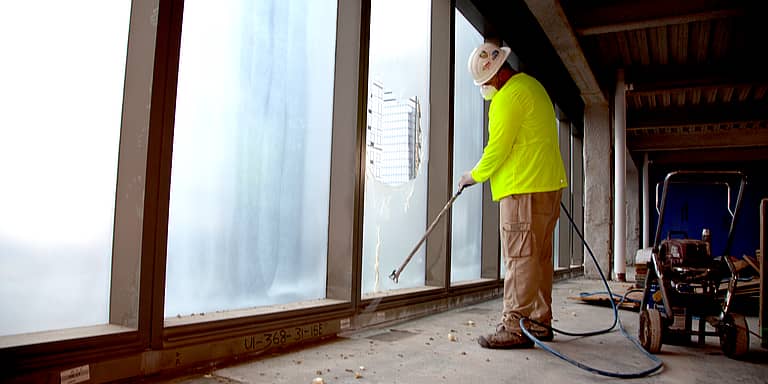Construction has continued to operate in most of Canada through the era of coronavirus, and while that is seen as good news for most workers on one hand, the nature of the work in many sectors has created a nervous and sometimes frightened workforce on the other.
And for good reason.
Many workers report lax hygiene standards and inadequate social distancing measures—particularly on busy sites where numerous subtrades scramble to meet deadlines. That is the case in the country’s biggest city, Toronto, where the pace of construction is as brisk as ever.
Going Up?
Dan Daly is president of P.J. Daly Contracting, a large wall and ceiling contractor based in Hamilton, about 40 miles southwest of downtown Toronto. He says keeping workers safe through COVID-19 should be a priority for every employer in the field, but that is not always the case.
Daly says he’s fortunate that his firm is not performing any contracts right now on large projects where health and safety standards around COVID-19 are difficult to meet. However, he is aware of problems on a number of big projects in the Greater Toronto Area that impact many trades, including wall and ceiling subs.
At some high-rise residential jobs in downtown Toronto, for example, elevator hoists with load capacities of 10 to 12 workers in normal times now are restricted to carrying only two or three workers in compliance with social distancing rules that require workers to be 6 feet apart. Those rules are not always met, however. That is because on busy sites, hoist wait times for workers can be 30 to 45 minutes. Towers of 30 stories or taller are a good example.
Daly, who is the president of the board of directors of the Interior Systems Contractors Association of Ontario, says waits affect production and can cause general contractors to pressure their subtrades to change their practices—putting more workers on hoists and breaking social distancing rules. ISCA represents about 80 contractors and 30 manufacturers/suppliers, employing over 10,000 members of the International Union of Painters and Allied Trades and the United Brotherhood of Carpenters and Joiners of America.
Mark Lewis, general counsel of the Carpenters District Council of Ontario, says one solution to the lineups at hoists is for GCs to stagger the times when subtrades enter the job site.
More Workers, More Risk
But social distancing problems are not easily solved in many corners of a project, especially those that have more workers on them than in normal times. Lewis says when the Ontario government closed some construction sector projects in April—deeming them non-essential—to avoid having to lay off employees some contractors reassigned “good workers” to their projects deemed essential. “This has led to some sites suddenly having an increase of workers. In a lot of situations it has made social distancing rules impossible to meet,” Lewis says.
Construction defined as essential by the Ontario government includes hospitals, roads and infrastructure underway prior to COVID-19, and many residential projects.
Lewis says at the general counsel (the carpenter union’s legal department), reviews are conducted of site-specific problems reported by union representatives, union stewards and health and safety representatives on sites across the province. The Carpenters District Council is comprised of 16 affiliated local unions of the United Brotherhood of Carpenters and Joiners. In the Greater Toronto Area that includes the Drywall Acoustic Lathing and Insulation Local 675, which represents about 7,000 interior workers. Also affiliated are Carpenters Locals 27 and 1030.
He says at the start of the crisis earlier in the spring there were “lots” of sites without running water for workers to wash up, but increasingly GCs have installed sanitation stations with soap dispensers and running water on each floor of a project. “Although the situation is getting better,” he says, “it is questionable on a lot of sites … in Ontario.”
And then there are employers who simply aren’t taking the coronavirus seriously. At one low-rise residential site, the builder simply installed a water hose for the subtrades and posted a sign that said “Bring your own soap,” Lewis points out.
Taper Chris Gibbs brings his own hand soap to job sites but recently found it missing at a residential subdivision where he was working 25 miles north of downtown Toronto. “Can you believe someone stole it?,” Gibbs asks. Making sanitation matters worse at the site, the portable washroom near the residence he was working in didn’t have running water, and the hand sanitizer dispenser was empty.
Walking Off the Site
A sole proprietor who does piecework, 51-year-old Gibbs was working for Maxum Drywall at the time in Caledon (in Ontario). Meeting health and safety standards starts with the builder (not the drywall contractor) and on some sites like the one in Caledon the standards have been lax. “As far as sanitation goes, it has not been a priority on the site …,” he says.
The health and safety concerns got so bad that carpenter and bricklayer trades walked off the job site, Gibbs adds. “Those trades are in close contact with each other, I am not. We (tapers) tend to be left alone because we need a big area to work in. That is one of the perks of the trade.”
But without framers to do their job, drywallers run out of work, leaving tapers like Gibbs in a pinch left to look for work elsewhere. “A lot of us blue collar guys work paycheck to paycheck, so we need the work,” he says. To fill gaps, Gibbs contracts out for several drywall contractors in the GTA.
While he is unaware of any workers coming down with the virus, because the subdivision had multiple builders that information would be difficult to obtain, he says, adding that Maxum Drywall requires him to fill out a screening questionnaire weekly. “If we show any symptoms (of the virus), we have to go off site,” he says.
Gibbs says a lot of residential subdivisions are doing a better job of meeting COVID-19 standards than the Caledon subdivision. “The thing is, it took this (outbreak) to raise the health standards (particularly for portable washrooms),” he says. “The pandemic has brought a magnifying glass to it and amplified the issue for government, but we have complained about these issues for years.”
Lewis points to other concerns he has heard from subtrades such as a lack of social distancing when workers (often three to six) are transported from one site to another in a van or truck “because that is (traditionally) how you get a crew to job sites through a day.”
GCs Can Make a Difference
Claudio Mazzotta, representative of the Drywall Acoustic Lathing and Insulation Local 675 in Toronto, says one drywall contractor told him all of his workers have to be tested for COVID-19 because they are working in an existing hospital. With a crew of 40, the testing results in a loss of up to 40 or so hours of production time.
While statistics on construction workers with the coronavirus were unavailable, the industry will inevitably see its share of workers catching the virus because social distancing rules are either not in place or are simply difficult to meet. Wallers usually work in pairs, making the 6-foot separation rule difficult, if not impossible, to meet, points out Mazzotta, adding that on equipment such as some scissor lifts, workers have to be close.
Daly adds social distancing and hygiene standards vary, depending, too, on the general contractor. “Some are making different rules. Some go overboard … some require you to wear masks all the time,” he says. And some of them expect workers to bring their own masks and other personal protective equipment even though Ontario’s Occupational Health and Safety Act stipulates that the employer must provide PPE.
Lewis says there are instances of contractors going as far as issuing respirators for side-by-side workers. Others are lax in their PPE approach. He has even heard reports that Ontario Ministry of Labour health and safety inspectors have told workers that “social distancing doesn’t apply” on essential workplaces. “That has been a major concern for us,” he says.
Various Reactions
The Carpenters District Council advises workers to walk off a job if they think the conditions are unsafe, have poor hygiene facilities or social distancing regimes are poor. In some cases, workers have pre-existing health conditions, or young children with health issues, or they live with elderly parents—the latter a common scenario in some of Toronto’s inner city ethnic communities, says Lewis.
He says “seasoned, tough construction workers” have broken down in tears over phone calls to the union about unsafe work conditions. The union urges employers to lay off workers in such situations. Workers can file for employment insurance or the new Canada Emergency Response Benefit claims recently implemented by the federal government.
At P.J. Daly Contracting, if employees—some of whom have been with the company for 30 or more years—have concerns about their safety on a worksite, the company will try to find them work elsewhere, says Daly. “We do have work around our shop: do spring cleaning, organizing equipment ….”
In Daly’s role as president of the board of directors at ISCA, he meets with the board over the phone once weekly to provide updates on the status of the industry “to make sure we are getting this right. The bigger union contractors are taking health and safety “very seriously,” he says.
Keep the Good Hygiene Practices
Horacio Leal, a representative of Carpenters Local 27 in Toronto, believes that 70 to 75 percent of the GCs on union job sites are doing a good job of meeting health and safety protocols for their subtrades. Leal cites a large hospital addition on Toronto’s east side as an example. There, EllisDon, the general contractor, has installed wash/disinfectant stations with blow-dry equipment on each floor, and additional change rooms for workers to minimize close contact. Coffee and lunch stations are cleaned frequently, and work breaks are staggered to meet social distancing standards. Washrooms have separate uses, separate access/egress and are cleaned daily—sometimes up to three times.
Leal says in the 35 years he has been in the field he has never seen such high hygiene standards. He hopes when the coronavirus has passed, the health and safety standards will continue. “If we can do it now, why not also in three months from now?” he says. Think of the costs of hiring sanitation crews as an investment against potential lost worker productivity because of illness.
Daly says his company has wall and ceiling contracts for several low-rise seniors’ homes in and around Hamilton and the Niagara region. Work is down about 30 percent because of the virus, but he knows other contractors in the GTA that have seen a boost in jobs since the coronavirus. Others, however, are facing tough times, and the industry could see some contractors go under if the crisis carries on past September.
Don Procter is a freelance writer in Ontario, Canada.








